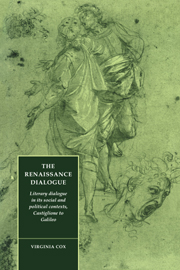 The Renaissance Dialogue
The Renaissance Dialogue Published online by Cambridge University Press: 05 December 2011
Oggi di … quasi tutti siamo rivolti col pensiero a contrattare
Stefano Guazzo, La civil conversazione (1574)One of the principal discrepancies between modern and pre-modern perceptions of literary discourse is that literature is no longer conceived of today, as it was within the classical, rhetorical tradition, as something ‘continuous with reality’, as ‘action in the world’. Like a classical oration, a Renaissance literary work was often addressed to a specific, closely studied audience and intended to persuade its listeners to a particular line of action. Indeed, in the Renaissance, when the writer's intentional audience was less likely to be a crowd than a small group of acquaintances and patrons, the art of ‘accommodating’ discourse to the expectations of its listeners became still more important than it had been in classical times.
The close and sociable nature of the relationship between writers and readers in the Renaissance courts affected the character of literary production in every conceivable way. In an age in which few writers were able to earn a living by their art alone, authorship constituted one element, among others, in a courtier's career. This meant that, besides its stated aims of instructing and delighting, literature was called on to perform a variety of ‘public relations’ functions for its author, ranging from flattery and self-advertisement to sniping and self-defence. Genres like the occasional poem or the commemorative dialogue represent only the tip of an iceberg of a literature gauged for its perlocutionary effects.
To save this book to your Kindle, first ensure [email protected] is added to your Approved Personal Document E-mail List under your Personal Document Settings on the Manage Your Content and Devices page of your Amazon account. Then enter the ‘name’ part of your Kindle email address below. Find out more about saving to your Kindle.
Note you can select to save to either the @free.kindle.com or @kindle.com variations. ‘@free.kindle.com’ emails are free but can only be saved to your device when it is connected to wi-fi. ‘@kindle.com’ emails can be delivered even when you are not connected to wi-fi, but note that service fees apply.
Find out more about the Kindle Personal Document Service.
To save content items to your account, please confirm that you agree to abide by our usage policies. If this is the first time you use this feature, you will be asked to authorise Cambridge Core to connect with your account. Find out more about saving content to Dropbox.
To save content items to your account, please confirm that you agree to abide by our usage policies. If this is the first time you use this feature, you will be asked to authorise Cambridge Core to connect with your account. Find out more about saving content to Google Drive.